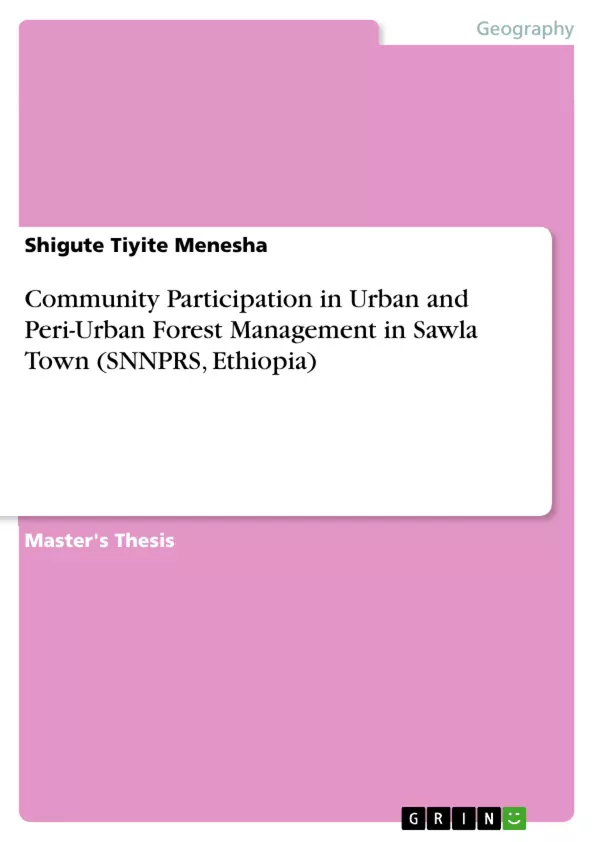This research explored the community participation in urban and peri-urban forest management (UPFM) in Sawla town of SNNPR State. The research design employed was descriptive method. The urban and peri-urban forests in Sawla are overwhelmed by pressures inherent to the extraordinary form of urban development such as rapid increase of urban population, poverty, land tenure insecurity, weak of institutional responses, lack of proper environmental planning and implementation and management restrictions.
The potential opportunities related to developing, managing and conserving the existing urban and peri-urban forest such as in farmland, homestead, streetsides, buildings, park lots, boulevards, hotels, central business centers, religious houses and graveyards, monument, cemeteries, riversides and streamlines, riparian areas, open spaces and peri-urban lands and public institutions.
The local community preference to pay money, extend labor and direct involvement and forms of participation such as peasant forestry, functional group forestry, fundamental group forestry, village forestry and public forestry are most important tools to rejuvenate UPFM. There are obstacles such as the living standards people, land tenure insecurity, level of awareness of local community, weak institutional arrangement and laws enforcement that made local people unwilling to participate in UPFM.
Inhaltsverzeichnis (Table of Contents)
- CHAPTER ONE: INTRODUCTION
- 1.0. Introduction
- 1.1 Background of the Study
- 1.2. Problem Statement
- 1.3. Objectives
- 1.3.1 General Objective
- 1.3.2 Specific Objectives
- 1.3.3 Research Questions
- 1.4. The Significance of the Study
- 1.5 Scope of the Study
- 1.6 Background of the Study Area
- 1.7 Limitation of the Study
- 1.8. Definition of Terms
- 1.9 Conclusion
- CHAPTER TWO: LITERATURE REVIEW
- 2.0 Introduction
- 2.1 Conceptual Framework of Participatory Urban and Peri-urban Forest
- 2.1.1 Participatory Urban and Peri-urban Forest Management
- 2.1.2 Concept Community Participation
- 2.1.3 Typologies of Community Participation
- 2.2.1 Factors Affecting Community Participation
- 2.3 Community Willingness to Participate in UPFM
- 2.4 Forms of Community Participation in UPFM
- 2.5 Local Authority Incorporation Community Participation in UPFM
- 2.5.1 Current Practices Community Participation in UPFM in Ethiopia
- 2.5.2 Legal Framework on UPFM in Ethiopia
- 2.5.3 Participatory Urban and Peri-urban Forest Management in Sawla
- 2.6 Conclusions
- CHAPTER THREE: METHODOLGY
- 3.0 Introduction
- 3.1 Research Design
- 3.2 Types of Data Sources
- 3.3 Sampling Techniques
- 3.4 Instrumentation/ Data Collection Methods
- 3.5 Data Analysis/ Treatment of Data
- 3.6 Conclusion
- CHAPTER FOUR: RESULTS AND DISCUSSION
- 4.0 Introduction
- 4.1 Response Rate
- 4.2 Respondent's Socio-economic Characteristics
- 4.2.1. Knowledge, Perception and Consumption Pattern of Forest in Respondents
- 4.3 Community Willingness to Participation in UPFM
- 4.3.1 Community Interest in UPFM
- 4.3.2 Conditions that Foster Community Participation in UPFM
- 4.3.3 Factors Affecting Community Willingness to Participate UPFM
- 4.4 Forms Local Community Participation UPFM Programs
- 4.5 Institutionalization and Community Participation in UPFM
- 4.5.1 Community Participation in UPF Co-management Activities
- 4.5.2 Legal and Institutional Framework
- 4.6 Conclusion
- CHAPTER FIVE: CONCLUSION AND RECOMMENDATIONS
Zielsetzung und Themenschwerpunkte (Objectives and Key Themes)
This research examines community participation in urban and peri-urban forest management (UPFM) in Sawla town, Southwest Ethiopia. It explores the current state of community participation and forest resources in the area, as well as the factors influencing community willingness to participate in UPFM. The study seeks to identify opportunities to promote community involvement in UPFM and address existing obstacles.
- Community participation in urban and peri-urban forest management
- Factors influencing community willingness to participate in UPFM
- Opportunities to promote community involvement in UPFM
- Challenges to community participation in UPFM
- Recommendations for improving community participation in UPFM
Zusammenfassung der Kapitel (Chapter Summaries)
Chapter One provides an introduction to the study, outlining the background, problem statement, objectives, significance, scope, limitations, definition of terms, and concluding with a summary of the chapter. Chapter Two reviews the relevant literature, exploring the conceptual framework of participatory UPFM, examining factors affecting community participation, and discussing the forms and practices of community participation in UPFM. Chapter Three details the methodology employed in the research, including the research design, data sources, sampling techniques, data collection methods, data analysis, and concluding with a summary of the chapter. Chapter Four presents the results and discussion, analyzing the response rate, socio-economic characteristics of respondents, community willingness to participate in UPFM, forms of local community participation in UPFM programs, and concluding with a summary of the chapter.
Schlüsselwörter (Keywords)
This research explores key concepts related to community participation in urban and peri-urban forest management (UPFM), including factors influencing community willingness to participate, opportunities to promote involvement, and challenges to participation. It also considers various forms of community participation, the legal and institutional framework surrounding UPFM, and recommendations for improvement.
- Citation du texte
- Shigute Tiyite Menesha (Auteur), 2010, Community Participation in Urban and Peri-Urban Forest Management in Sawla Town (SNNPRS, Ethiopia), Munich, GRIN Verlag, https://www.grin.com/document/1037102



